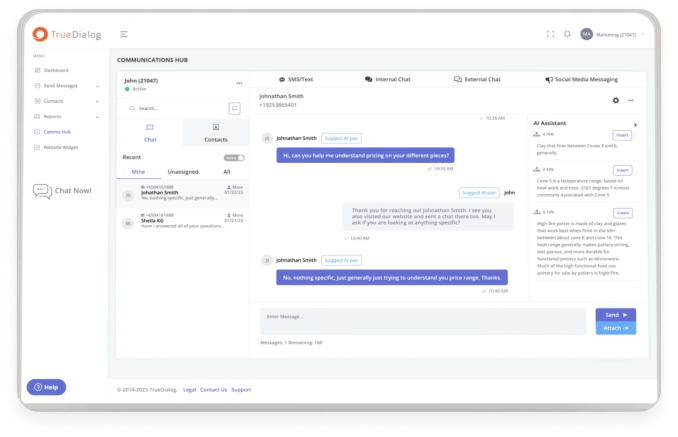Texting students is about more than just boosting enrollment and getting the highest possible number of students to graduation day. It’s about supporting them as individuals, with a thoughtful eye on their physical and mental wellbeing.
For example, research has shown impactful results when colleges use an SMS text messaging platform to send their students check-ins and resources. Let’s take a closer look at some use cases and what was achieved:
- Quitting smoking: Students in one study who received supportive texts from their college were more than 50% more likely to quit than those who did not receive the texts.
- Healthy eating: In another study, students who received texts with healthy eating resources were better able to establish good habits and avoid unwanted weight gain.
- Safer drinking: Yet another study showed that when students received alcohol-reduction intervention texts, they were less likely to binge drink and reported fewer hangovers.
Another way colleges can empower their students is through check-in messages from counselors. Individuals who are at risk of failure often improve performance when they’re kept on track through these types of personalized text messages.
All of these examples highlight the power of consistency when it comes to supporting students. Messages might contain robust resources or simply be a motivational quote. Their efficacy comes from the cadence and reliability of the touchpoints.
Ways to Support Wellness
Mental health is another crucial area where colleges can provide resources and intervention. Most college students are at a particularly vulnerable stage of their lives, with 75% of lifetime mental health problems appearing by the age of 24. Consider these statistics regarding the mental health of American college students:
- Depression increased by 135% from 2013 to 2021;
- Anxiety increased by 110% in that same period;
- The number of students with mental health problems doubled in that same period.
Amid this epidemic, text messages provide an effective outreach tool because most students struggling with mental challenges are unlikely to seek out help. Why? Here are five of the most common reasons that individuals who have mental health challenges fail to take positive actions:
- Fear of people finding out about their condition;
- Not knowing what kind of help to seek;
- Unsure of where to get help;
- Fear of being forced to take medication;
- Unable to afford treatment.
When colleges use text messages to communicate with students, they’re able to navigate many of these objections. First, they are able to conduct the dialogue privately. Students who may be ashamed to step foot in a counseling center will often feel comfortable responding to text messages.
Beyond that, text messages provide a way for colleges to offer free resources to those who lack knowledge or have concerns about available support systems. Students who might be afraid of having treatment forced upon them are often more willing to participate in these low-stress conversations via their phones.
Customized Messaging for Personalized Results
Every college has its own strategies and priorities when it comes to supporting students, so there’s no one-size-fits-all approach to mental health support. But it’s important to note that even the smallest steps forward can make a big difference for students.
For example, you could send out periodic texts to students asking students to rate how they are feeling that day. If the response is below a certain threshold, you might offer encouragement, send resources, or even have a counselor reach out and to offer direct assistance.
The most important thing is that students feel like they have a safe place to share concerns and that there is help available, if they choose to seek it.
The Unique Role of Texting
Many colleges are currently using emails as a primary communication method to reach students. But that approach offers lower deliverability, fewer opens, and less engagement than text. If you want to truly connect with students and deliver the most important messages and resources, an SMS text messaging platform is essential.
Research shows that the majority of Americans are on their phones at least five hours a day. This is particularly true for student-aged individuals. It’s where they’re engaging with content, so it’s where you should share it.
The performance disparity between email and text is stark, with email only generating a 20% average open rate and text messages enjoying a 98% average open rate. The low open rates for email can partially be explained by a generational preference for text. But it goes deeper than that.
Students’ inboxes are often piled high with various business and education-related messages, making it easy to miss even a high priority email. A text is simply more likely to get noticed, as it tends to be quicker to read and won’t be obscured by the sheer volume of an email inbox.
Another limitation of email messages is that they require an internet connection to be received. Texts aren’t restricted like this, enabling students to get crucial messages even when they’re in areas that lack the right internet signal.
For these reasons and more, texts get opened more often, with faster responses than emails. Research shows that the average text gets a response within 90 seconds. For emails, the average response time also involves the number 90, but you have to swap the word “seconds” out for “minutes.” Yes, the difference is that drastic.
Just Be Sure You Can Deliver a Great Experience
While texting is an advantageous way to communicate with students, it will only succeed if it’s backed up by solid strategy, the right resources, and a reliable system. You’ve got to make sure everything is set up in your SMS solution long before you hit “send.”
For example, if your SMS text messages allow at-risk students to connect with a mental health counselor, you’d better have a plan in place to make those connections happen so that interested individuals aren’t left in limbo. Or if you are reaching out to students about safe drinking habits, make sure you have a strong supply of quality content lined up. That way, when students sign up to receive your automated text message, they’ll be rewarded with consistent, valuable information.
TrueDialog is built specifically for higher education and serves some of the nation’s largest public and private schools. Our higher education SMS text messaging platform allows customers to communicate with any audience at scale. And these text messages are exchanged securely, which encourages students to respond honestly and without fear of their information being compromised.
Put Your Plan in Place
You are an expert in delivering the best support to your students. Leveraging the best SMS text messaging platform for your communications strategy allows you to magnify what you do best and reach even more students.
Because TrueDialog has built direct carrier connections, as opposed to simply plugging into third-party APIs, we’re able to offer exceptionally competitive rates. Enterprise education customers receive our Campus Alert System at no charge, which is an example of text-based communications when it’s most critically important.
Call us today to learn more about how we can streamline your institution’s SMS solution, bolster your communications strategy, and save you money.
It’s easy to sign up for a free 15-day trial so that you can start crafting, scheduling, and sending text messages. And we’ll even show you how to track your messages so that you can ensure performance quality and continue refining your strategies.






